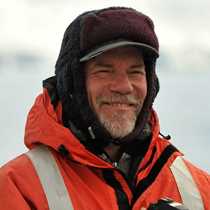Edgeoya, Storfjorden & Heleysundet, Svalbard
In the ten days since we left Bergen on the west coast of Norway, the National Geographic Explorer has cruised a remarkable variety of beautiful seascapes. The scenery around us has changed almost constantly as we have cruised from the deep, still waters of the miles-long fjords that cut into the heart of the granite coastal mountains to the low glacier-ground islands outside the mouths of the fjords, from the fluted peaks of the Lofoten Islands to the gentle hills that surround Tromsø, and from the towering vertical cliffs of Bear Island to the pack ice and tundra valleys of Storfjorden and Edgeoya.
Equally, the waters we have cruised have changed constantly beneath our ship. Using NG Explorer’s underwater video cameras and ROV, these shifts of marine scenery and ecosystem have also become a part of our experience on this long northbound expedition.
For the first half of the voyage, from Bergen to Tromsø, a difference of 11 degrees of latitude and a journey for us of nearly 1000 nautical miles, the water temperature remained remarkably constant at about 9ºC (48ºF). Nevertheless, we had opportunities to look into several very different marine environments. We began in the innermost reaches of Nordfjord, where a layer of cloudy fresh water overlays the seawater below and restricts the marine community to a few hardy species including a fascinating symbiotic pairing of a hermit crab (Pagurus prideaux) and an anemone (Adamsia palliata) that mimics the gastropod shells the crab normally wears as protection.
Moving to the outer coast we looked into the rich and beautiful kelp forests of the Lofoten Islands and then, returning to the fjords, used the ROV to take a look at the depths of Tysfjord, exploring as deep as 650 feet where we found the lovely deepwater octocoral Primnoa resedaeformis.
Next, making the leap across to Bear Island, a change of only 3 degrees of latitude, we began to feel the influence of the East Greenland current and entered truly arctic waters whose temperatures hover close to the freezing point year-round. A dive beneath the soaring bird cliffs revealed a community of beautiful and brightly colored anemones, sponges, and ascidians (sea squirts), bushy sea cucumbers, hidden crabs and busy barnacles, all tightly packed together on the rocky walls where the cliffs plunge below into the sea.
This is a journey made by many before us. Whalers, polar explorers, pioneering biologists and many more have made their way up the spectacular coast of Norway and on into the Arctic. It is a fantastic opportunity to explore the beauty and the science of the North Atlantic and, building in excitement as we go, it always feels to me like a real adventure.



